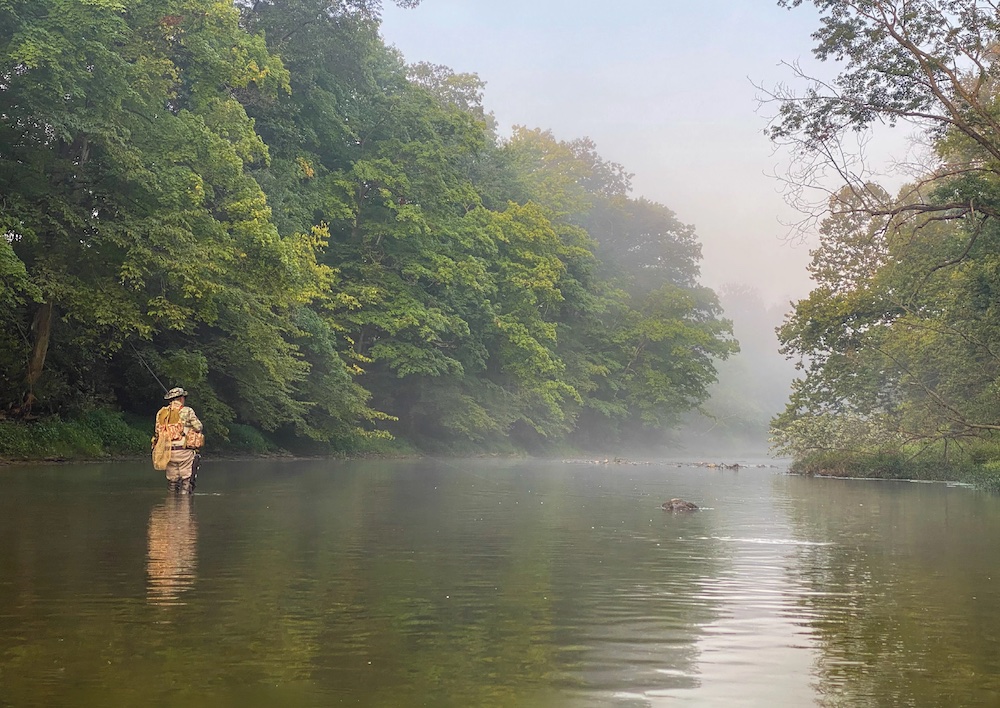
Nationwide, hundreds of small streams hold surprisingly big smallmouth bass, yet many are seldom fished. One angler who consistently mines bronze from these overlooked waters is Indiana B.A.S.S. member George Verrusio, the most skilled stream smallmouth fisherman I’ve met in my 52 years as a Bassmaster correspondent. Verrusio has spent a lifetime wading for smallmouth and has caught scores of big ones from creeks you can practically spit across. If you’re thinking of plunging into this minimalist mode of smallmouth fishing, his advice can help you uncover the untapped smallmouth potential of streams in your area. – Don Wirth
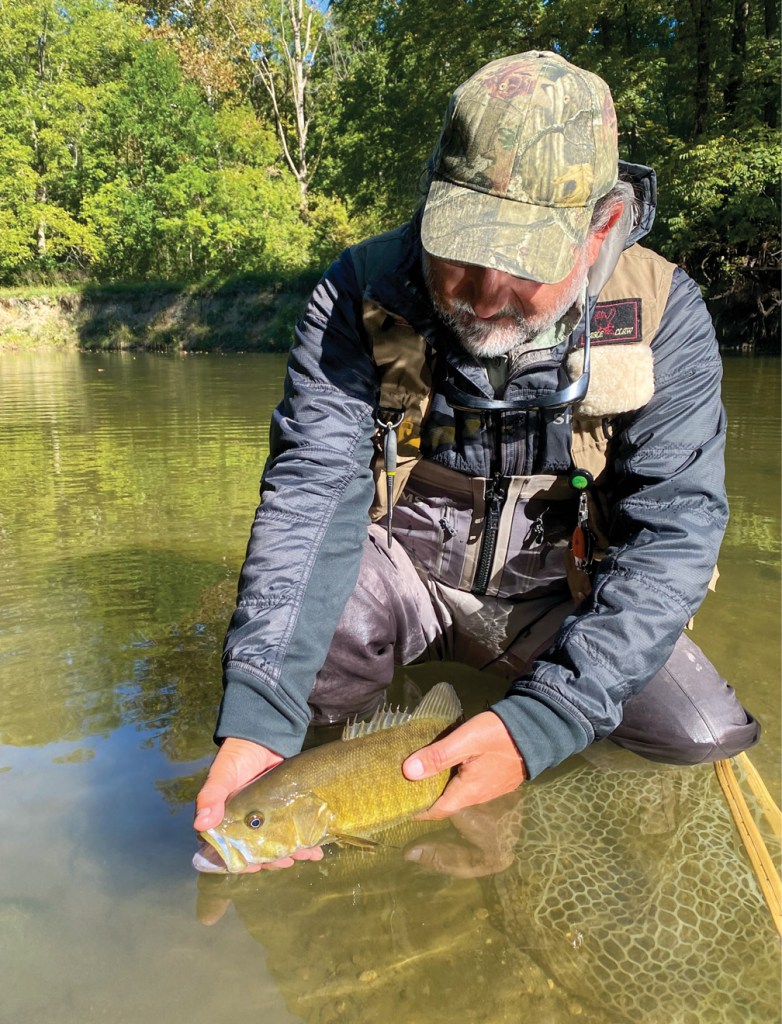
It was stinking hot the other day while I was wading a stream west of Indianapolis. As I took a shade break beneath a bridge, a truck pulling a bass boat clattered overhead, and I wondered if that fisherman realized he’d just driven over some prime smallmouth water. Then I stepped back into the sunlight and continued wading downstream. I’d recently caught a 22-inch smallie weighing nearly 5 pounds from that little creek, and I was intent on hooking into an even bigger fish.
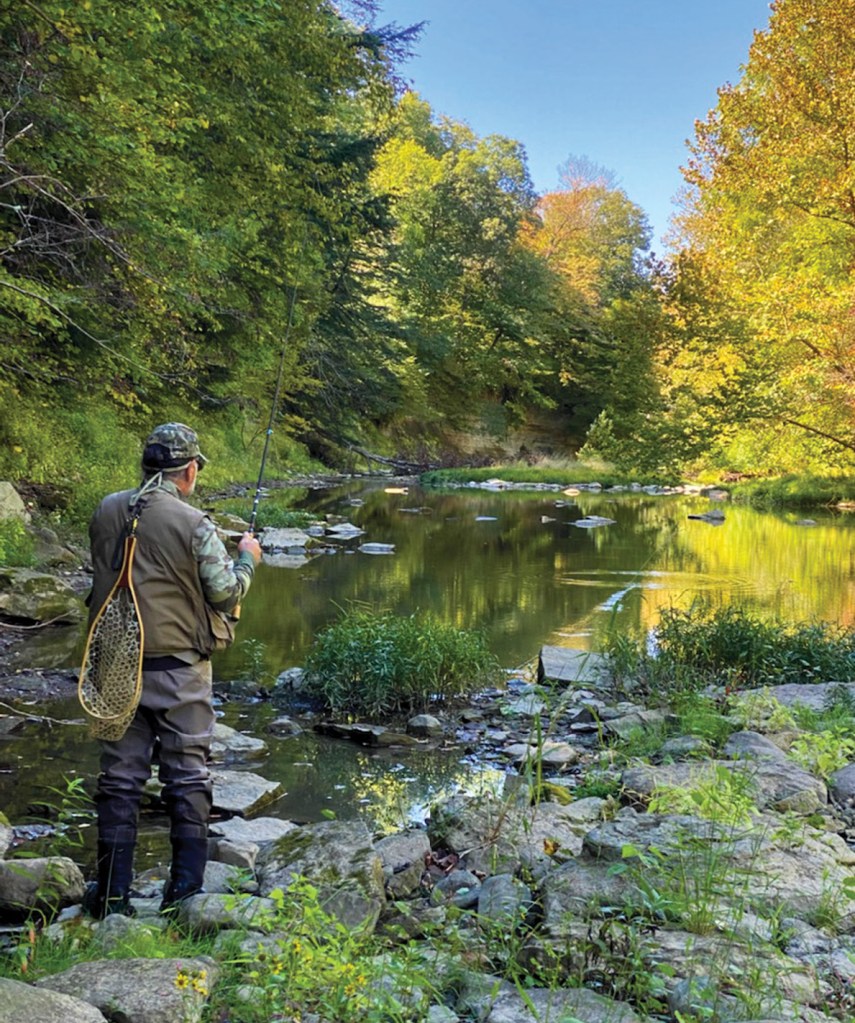
I’ve caught wall-hanger smallmouth from Lake Michigan, lunker Florida largemouth, big Tennessee stripers, even trophy peacock bass from the Amazon River. But to me, nothing tops wading for stream smallies. It’s a total escape from work pressure (I’m a real estate broker) and an incredible way to connect with nature — plus, it’s convenient (I can go from a business meeting to a nearby creek in minutes), and compared to “normal” bass fishing, it’s cheap (no boat, no gas-sucking tow vehicle and only minimal gear required). Most of all, it’s the challenge of stalking and battling big smallmouth on the fish’s level — both me and my quarry in the same water — that drives me to keep wading!
Many bass anglers have never caught an 18-inch smallmouth, but fish this size and bigger are available in plenty of creeks nationwide. My longest stream smallie spanned 23 inches. On one recent wade, my five best fish totaled 81 inches. Even though a creek may look too narrow or too shallow, I’ve found quality smallmouth are usually there. It just takes determination, the right gear and some basic know-how to catch them.
Stream smallmouth targets
Like all bass everywhere, stream smallmouth hold around submerged objects and will gravitate to something different in their surroundings, especially a sudden depth change. Here’s a breakdown of my favorite creek casting targets.
- Isolated rock and wood cover slows or diverts current and provides perfect holding/ambush spots for stream smallies. Midstream logs are especially productive and often have a washout (hole) under them where smallmouth can hide.
- Deep holes with a hard bottom (not sand or muck) and scattered, isolated cover are reliable fish holders, especially in fall and winter. Of course, “deep” is a relative term; some streams I wade have 3-foot holes; others have 10-footers.
- Laydowns (fallen trees) extending over the water provide shade and cover. Smallies will suspend around the ends of submerged branches where they can dart out into the current to grab a meal.
- Bottom depressions of as little as 1 or 2 feet can hold big fish, even when there’s no cover present.
- Points and flats with mixed gravel, chunk rock and scattered wood are money; smallies spawn on them in spring.
- Undercut banks with exposed tree roots have the ideal combination of depth, shade and gnarly cover to hold big smallmouth.
- Bridge pilings provide current deflection and shade; these usually have a washout as well.
- Water willow and other semi-aquatic plants can hold quality smallmouth, which typically prowl the edges and pockets within the cover versus the thick stuff.
- Current seams, eddies and switchbacks concentrate forage species and thus attract bronzebacks. “Reading current” is a skill that comes only with experience and will help you intuit where big smallmouth are probably sitting.
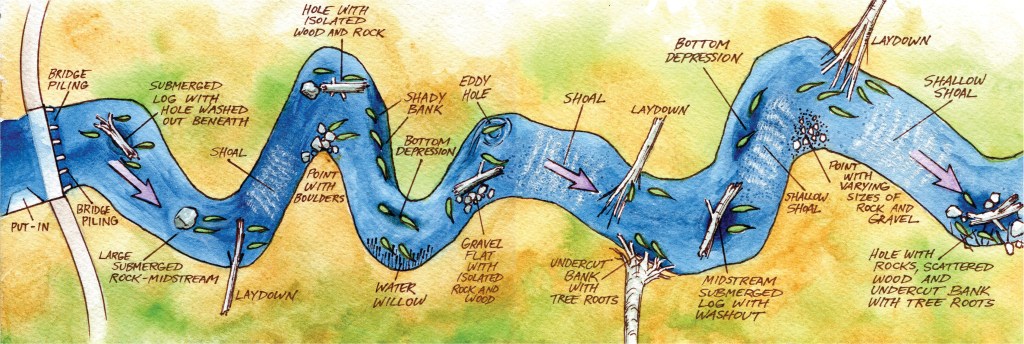
Dress for success
You’ve got to dress right to wade, regardless of the season. I fish streams from ice-out to ice-back-in. I’ve caught quality smallmouth in 37-degree water in January and when the air temp topped 100 in August. Trust me, if you’re too cold, too hot, too sweaty or if your feet or knees hurt, you can’t focus on fishing.
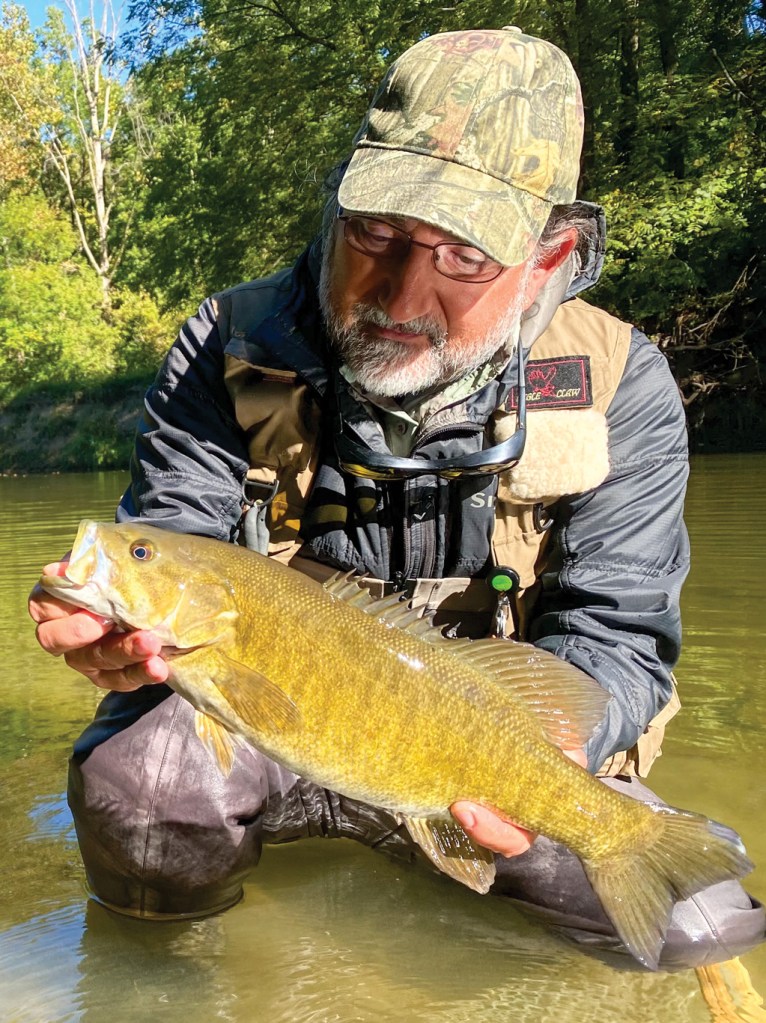
Unlike Bassmaster Elite Series pros, I don’t have sponsors supplying me with product. I buy my own fishing stuff, put it through the wringer and stay with what works. I’ve stomped around streams for four decades, and the best waders I’ve found are Simms G4Zs. They’re expensive (around $1,000) but worth it if you’re serious about creek fishing. Their big zipper makes them easy to get on and off quickly, and the fabric is breathable Gore-Tex, a godsend on strenuous wades. In cold water, I’ll wear insulated underwear and fleece wading pants under my waders. These layers keep me warm and negate the need for heavier and even costlier insulated waders.
Since your feet do most of the work when wading, you need the right boots. Mine are Simms Flyweights, which are super-light and durable. I also like Korkers DarkHorse boots, which have interchangeable soles — nice if you wade several creeks with different bottom conditions.
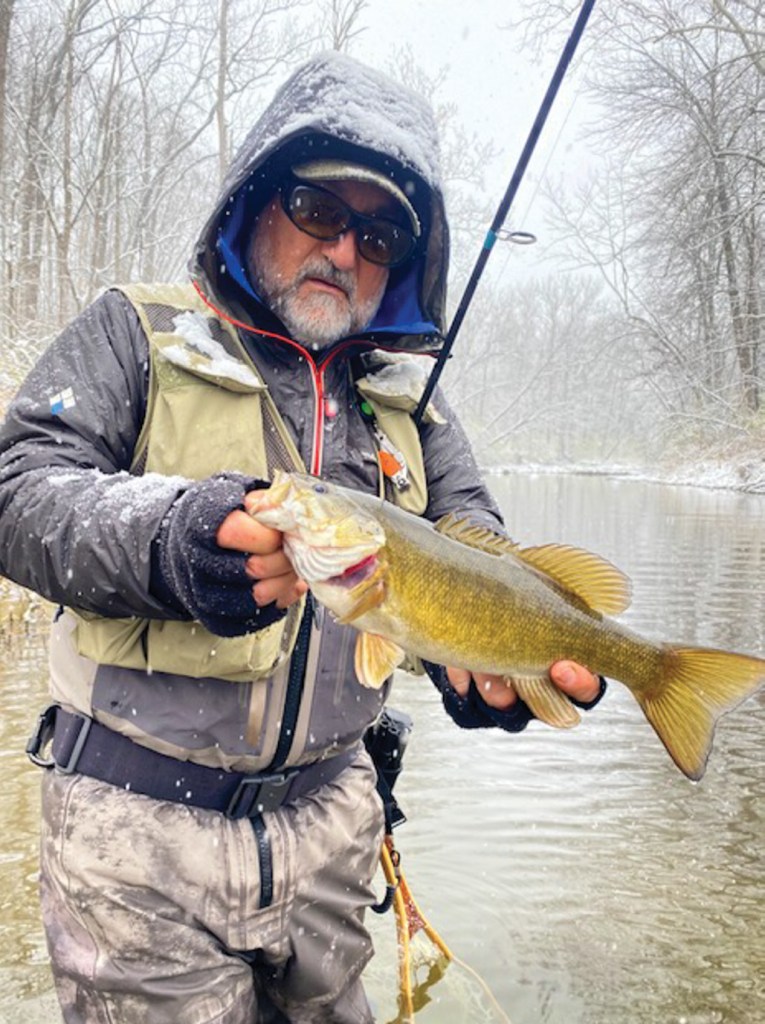
I’ll wear waders until the water temp climbs to around 65 degrees, then I’ll wet-wade with lightweight, quick-drying “guide pants” (not jeans — they soak up water like a sponge), a breathable fishing shirt with extra pockets and wading boots. Wading forces you to edit your equipment down to the necessities. Some creek anglers wear a backpack; I find these too bulky and constrictive, and I don’t need all that storage space because I travel light. Both my waders and my lightweight Simms wading vest have zippered pockets, which organize and secure my necessities: basic lures, pliers, clippers, rain jacket and cellphone (which I use only for photography). Of course, polarized sunglasses are mandatory, especially in clear streams where you’re often sight fishing for holding or cruising fish. My waders, fishing hat, shirt and vest are all a drab khaki color to avoid spooking these wary fish.
Putting in and taking off
Most bridges offer decent stream access, but understand that any stretch of water close to the most convenient access spots invariably receives the most fishing pressure. For this reason, I use Google Maps to scope out creeks and locate less obvious places to enter the water. (Tip: Deep water shows up darker in satellite photos.) I’m also willing to approach property owners and ask permission to cross their land to gain stream access, stressing that I’m a catch-and-release angler. I’ve rarely been turned down by politely requesting access.
Once you’re in the water, try to maintain a low profile and be as stealthy as possible. I can’t stress enough how wary stream smallmouth are. They’re highly susceptible to overhead predation by ospreys, herons and other birds of prey and are very aware of something moving above them (including you). Whenever you cast a shadow, raise your rod high or even pull a bait with a reflective finish out of your tacklebox so it glints in the sun, you risk spooking a fish. Once you understand that these fish are incredibly spooky, finding ways to keep a low profile becomes part of the fun and challenge of catching them. For example, when wading, I don’t shuffle my feet to avoid kicking up muck and debris, and I move slowly and deliberately across loose rocks to make a quiet approach. Then, when I’m within casting range of a target, I stand still, trying to blend into the background, and make long sidearm or loop casts. (The long, relatively stiff rods I use facilitate surer hook sets when I’ve got a lot of line between me and the fish.) When you’re in the fish zone, don’t move around too much. Try to be part of the landscape instead of an intrusive predator. I’ve had big smallmouth swim up to within a foot of me after I’ve stood stock-still for several minutes.
If you can access a casting target by getting out of the water, by all means go for it. Getting on the bank will reduce your chance of being spotted by the fish and will give you additional angles from which to cast. Just avoid stepping on snakes in warm weather!
Tackle and lures
I carry one spinning outfit when wading. My two favorite rods are a 7 1/2-foot St. Croix Legend Elite ES76MF and a 7-3 G.Loomis NRX+ 872; both are medium action with a fast tip. I pair these with either a Quantum Smoke S3 30 or a Lew’s HyperMag 300 reel. These are spooled with either 10-pound fluorocarbon or 8-pound mono. These combos work for every stream fishing scenario I’ve encountered.
Presentation tips
Many creek fishermen make a big effort to position themselves so they can cast upstream and retrieve their lure downstream with the current flow, believing this to be the direction in which stream forage invariably moves. This “rule” ignores the fact that stream smallmouth, like all bass everywhere, are opportunistic predators that will grab a meal when and where it becomes available and can be provoked into striking even when they’re not particularly hungry. Therefore I’ll make multiple presentations to a likely target from many different angles — downstream, upstream, crosscurrent — hammering away until I trigger a reaction strike from a fish. I once made 29 casts to a submerged rock where my gut told me a big smallmouth should be lurking, hitting it from every conceivable angle without success. On my 30th cast, I caught a 21-incher. Patience pays off.
I’ll spend considerable time probing a deep hole from every possible angle, keying especially hard on isolated cover. If the surface temp is around 55 degrees, I’ll start by twitching a Fluke or a jerkbait; if it’s 60 or above, I’ll begin with a surface bait. Then I’ll make a second pass with the Fluke or jerk. Finally, I’ll slow way down and bump bottom with a jig or Ned bait.
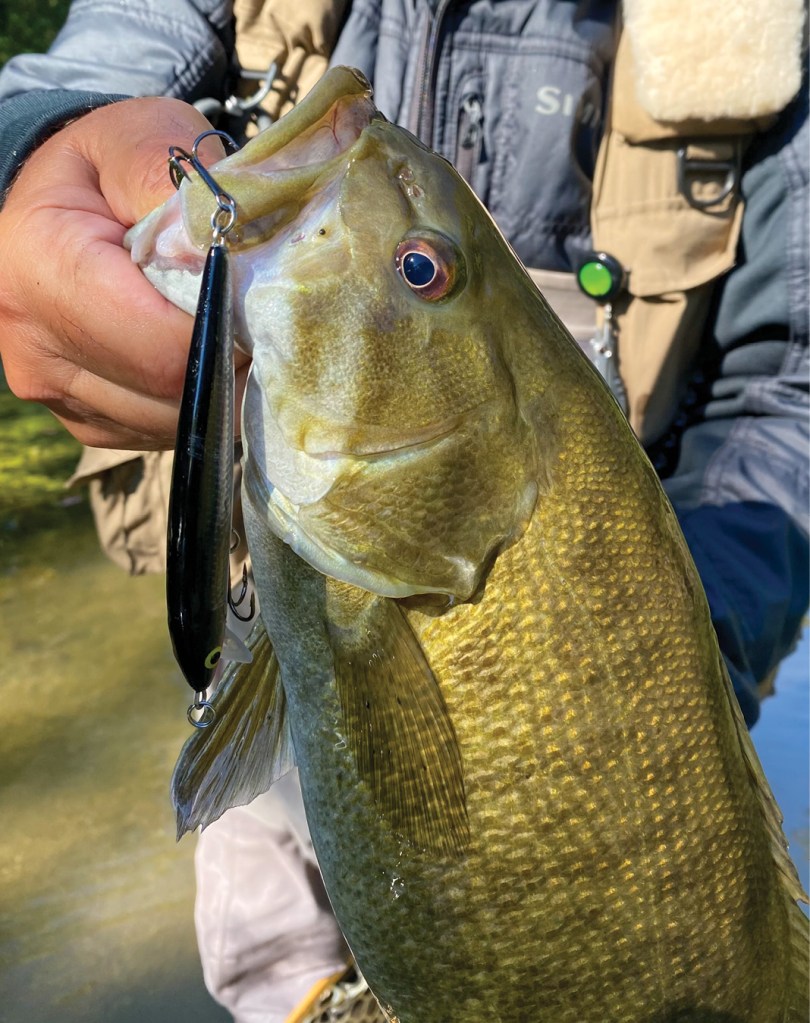
Even when I’m crossing a skinny shoal lacking in noticeable cover and thinking about how I’ll fish the hole or undercut bank that I’m heading for, I keep on casting. There might be a well-camouflaged lunker sitting in a subtle midstream bottom depression, or a big cruiser heading back to a current break after chasing a minnow into open water. In a stream environment, you really never know, so never stop fishing!
Lures to throw for stream smallies
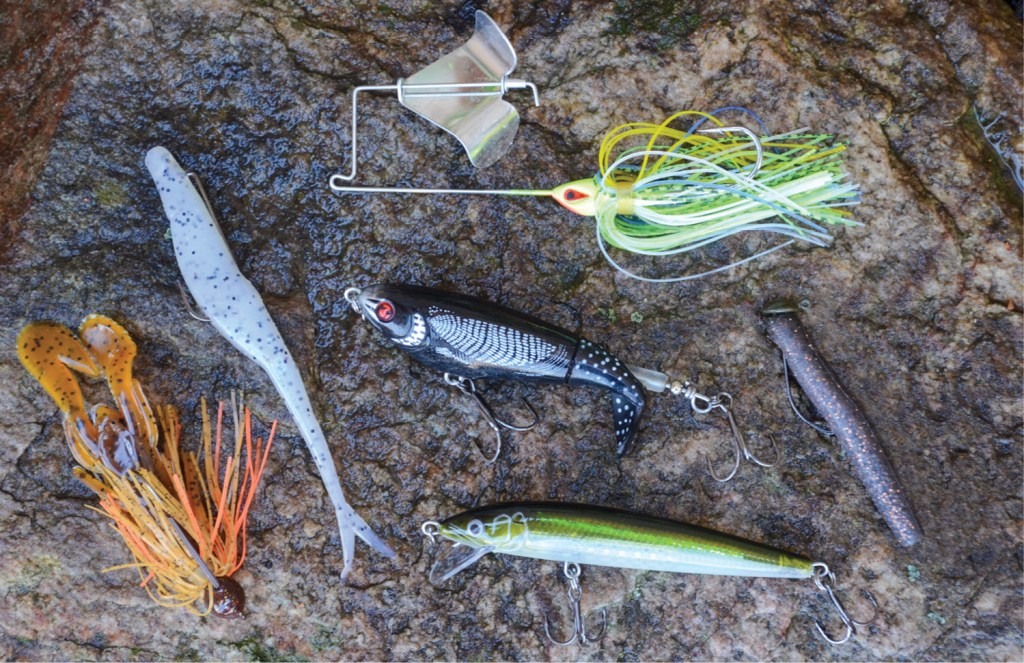
Finesse jigs — I use 1/8- through 1/4-ounce jigs paired with craw trailers in realistic crawfish colors to probe deep holes and isolated midstream cover.
Ned baits — These tiny artificials mimic worms, leeches and aquatic bugs. They’re my go-to baits for coaxing tough bites in deep holes. I fish them on homemade 1/16- through 1/4-ounce mushroom heads with stout No. 2 hooks.
Flukes — They resemble creek minnows and draw strikes when twitched across deep holes and around shoreline cover once the water temp reaches 55 degrees in spring.
Jerkbaits — I’ll work a 4-inch suspending jerkbait parallel to undercut banks and over submerged cover in deep holes.
Topwaters — Stream smallies will eat just about any critter swimming on the surface — I’ve seen ’em grab chipmunks, snakes, even small birds. This makes a buzzbait or a plopper-style surface plug an exciting option from spring through fall.
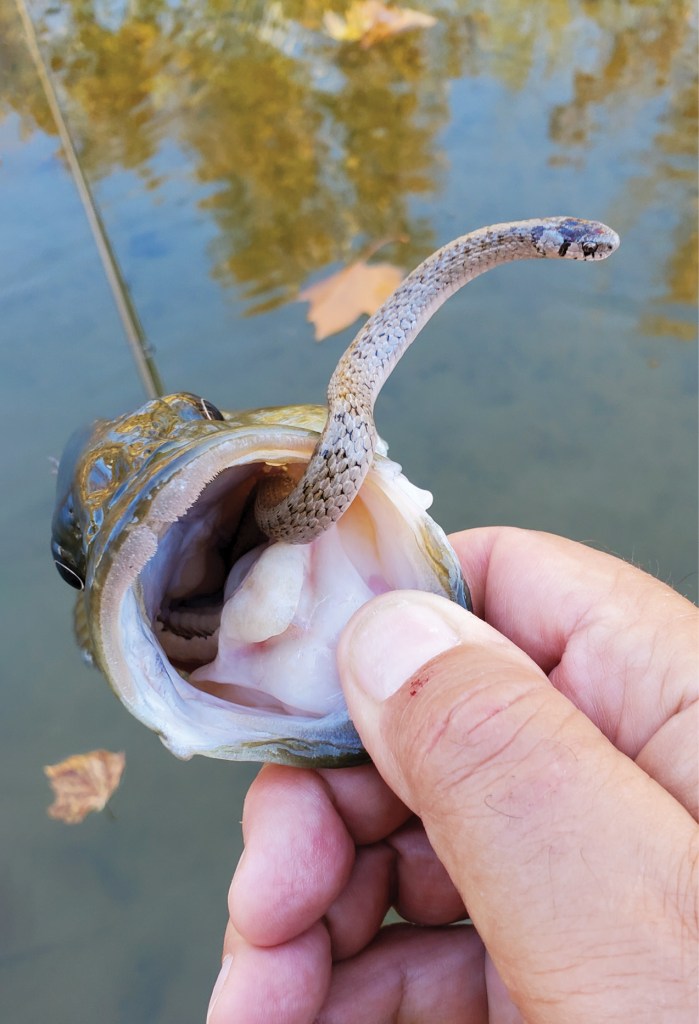
Six things you didn’t you know you needed when wading streams
Wading for stream smallmouth doesn’t require a lot of gear, but having the right stuff will allow you to fish these small waters more successfully. Here are some easily overlooked items that veteran Indiana creek angler George Verrusio wouldn’t wade without.
Boot insoles — “Wading is tough on your feet, knees, back and shoulders. I wear custom Upstep orthotic insoles (upstep.com) in my wading boots. These reduce aches and pains by promoting better posture and provide great cushioning in rocky streams.”
Wool socks and liners — “I haven’t found anything that will keep my feet really toasty in frigid water, but thick, midcalf Alpacas of Montana socks (alpacasofmontana.com) and Smartwool sock liners (smartwool.com) sure help.”
Wading staff — “A lightweight, folding wading staff ($50 to $150) improves your balance and helps you move more confidently in current, a real benefit when covering long, rocky stretches and when exploring places you haven’t waded before.”
Spare reel spool — “Load this with line that’s one step lighter or heavier than the line on your reel so you can adjust to varying water clarity conditions and lure weights.”
Landing net — “The reason we fish for smallmouth is [because] they’re badass. But trying to lip a hot smallie with a jerkbait in its mouth is asking for a hook in your finger. My handmade Wolf Moon C&R landing net (wolfmoonnetsusa.com) subdues feisty fish quickly and has a nice vintage look.”
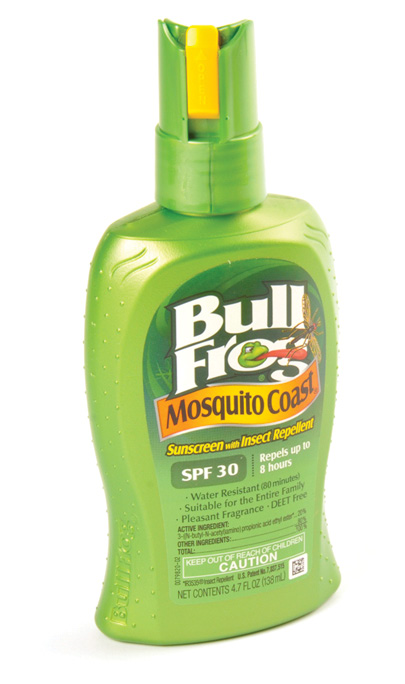
Insect repellent — “Trout fishermen talk about insect hatches like they’re a good thing, but black flies, mosquitos and no-see-ems? They’ll eat you alive when wading. Repellent in moist towelette form is lighter and more compact than bulky spray cans.”
Originally appeared in Bassmaster Magazine 2023.




